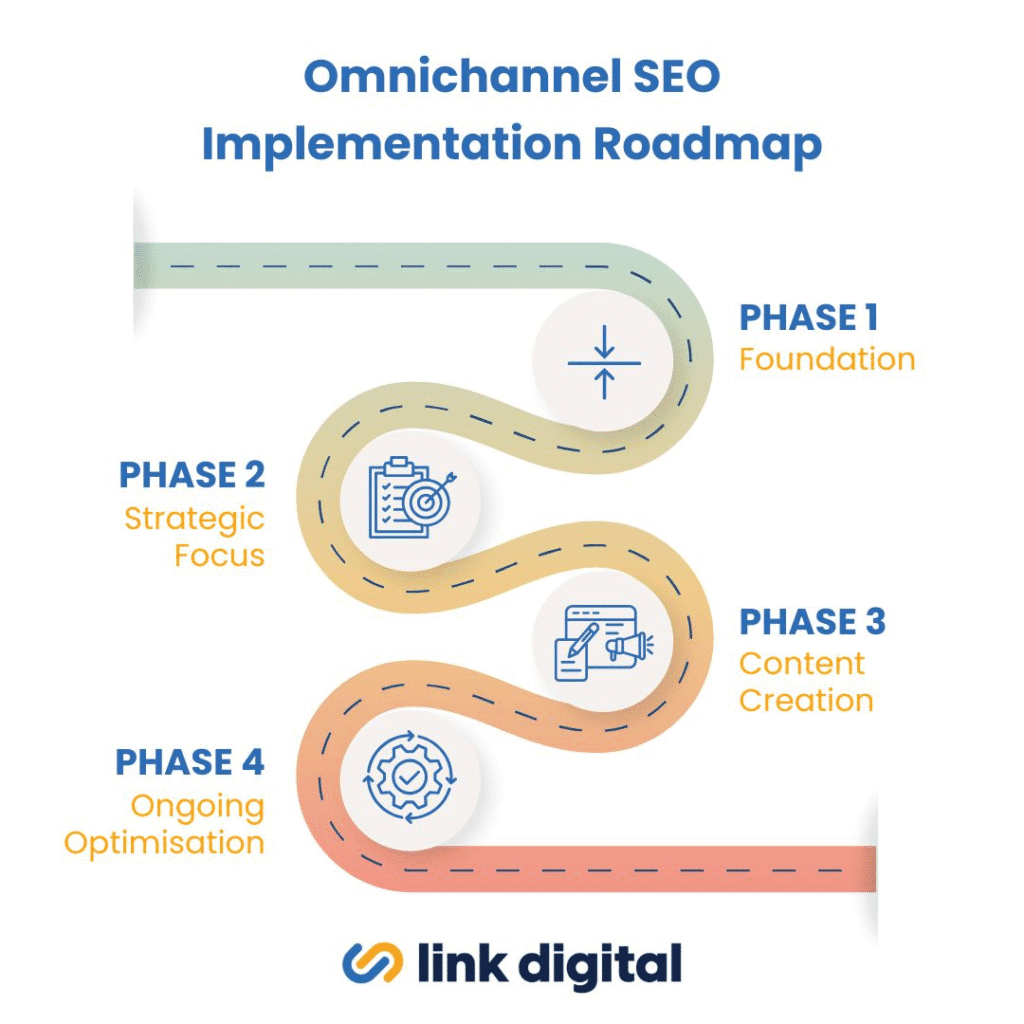
Free Digital Marketing Review
Elevate your online strategy with a personalised report and expert insights. Achieve your business goals faster!
Beyond Google: The Complete Guide to Omnichannel SEO
Picture this: Your potential customer starts their journey watching a “how-to” video on YouTube, compares prices on Amazon, checks out your company’s thought leadership on LinkedIn, and finally discovers your local business through a TikTok video—all before they even think about Googling you.
Sound familiar? That’s because today’s consumers don’t just search in one place anymore. They’re platform hopping their way to purchase decisions, and if your business isn’t visible across these touchpoints, you’re essentially invisible to a massive chunk of your market.
According to 2025 research from Instapage, companies that create personalised, multi-platform experiences see B2B order values increase by 40%, with 53% of buyers stating that personalisation directly drives their revenue growth.
The days of “SEO = Google optimisation” are over. Welcome to omnichannel SEO, where your visibility strategy needs to be as diverse and dynamic as your customers’ search habits.
What Is Omnichannel SEO?
Omnichannel SEO is the practice of optimising your content and presence across all platforms where your potential customers might search for products or services. It’s not just about ranking on Google anymore; it’s about being discoverable wherever your audience is looking.
Consumers are increasingly platform savvy, using different channels for different stages of their buying journey. They might discover a product on TikTok, research it on YouTube, compare prices on Amazon, and finally make the purchase decision after reading LinkedIn thought leadership from the company’s CEO.
An omni-channel approach to online marketing is the best route to go in 2025 and beyond. With consumers frequently switching between devices and platforms, businesses that provide a seamless, consistent experience across all channels, whether online, in store or through social media.
The Five Essential Platforms Every Business Should Master
1. YouTube: The UK’s Second Largest Search Engine
YouTube isn’t just for entertainment; it’s become a primary research tool for consumers. Whether someone’s looking for “how to fix a boiler in Hertfordshire” or “best accounting software for small businesses,” YouTube is often their first stop.
Your YouTube SEO action plan:
- Location-first content strategy: Create videos targeting specific regions. Instead of generic titles, use “Best Accounting Software for London Small Businesses” or “Emergency Heating Repairs in Manchester.”
- Long-tail keyword goldmine: Target specific phrases like “how to choose a solicitor in London” rather than broad terms like “legal advice.”
- Clear website direction: Every video should include verbal and written calls-to-action directing viewers to your website for more detailed information.
- Thumbnail optimisation: Design custom thumbnails that stand out in search results.
2. Amazon SEO: Capturing Ready-to-Buy Customers
Amazon’s marketplace isn’t just for sellers; it’s become a primary destination for product research. Even customers who plan to buy elsewhere often start their research on Amazon, making it crucial for product-based businesses.
Amazon optimisation essentials:
Keyword research tools: Use tools like Helium 10 or SellerApp to identify high volume, low competition keywords specific to UK searches.
Title optimisation formula: [Brand] + [Primary Keyword] + [Key Feature] + [Benefit] + [UK-specific terms if relevant]
Image strategy: Use lifestyle images showing your product being used by customers in familiar settings.
Review generation: Implement follow up email sequences encouraging genuine reviews. Products with 15+ reviews see 270% higher conversion rates.
Question monitoring: Set up alerts for customer questions and respond within 24 hours to improve your product’s search ranking.
Pro insight: Many consumers use Amazon for research even when purchasing through other channels. A strong Amazon presence can drive traffic to your main website and increase overall brand credibility.
3. LinkedIn SEO: The B2B Discovery Engine
LinkedIn has evolved far beyond networking; it’s now a primary search platform for businesses seeking suppliers, consultants, and professional services. With over 30 million UK professionals active on the platform, it’s essential for B2B visibility.
LinkedIn optimisation strategies:
Company page keywords: Include location specific terms like “Hertfordshire digital marketing agency” or “London accountants for startups” in your company description.
Content themes: Address specific business challenges such as “Navigating GDPR compliance for SMEs” or “Post-Brexit supply chain solutions.”
Employee advocacy: Optimise individual team member profiles to represent your company’s expertise areas. LinkedIn’s algorithm favours content from personal profiles.
Industry participation: Join and actively contribute to focused LinkedIn groups in your sector.
Local case studies: Share success stories featuring recognisable businesses or regional challenges.
4. TikTok: The Rising Star of Local Discovery
Don’t dismiss TikTok as just a platform for teenagers. Optimised TikToks can also show up in Google, and businesses are finding genuine success in reaching local customers through creative, authentic content.
TikTok business optimisation:
Hashtag strategy: Use trending hashtags. Research shows content with local hashtags gets 70% more engagement from regional audiences.
Behind-the-scenes authenticity: Show the real people behind your business. Audiences particularly respond to genuine, unpolished content over highly produced videos.
Educational micro-content: Share quick tips relevant to your industry. A 30 second “Did you know?” video often performs better than longer content.
Local collaboration: Partner with micro-influencers and local creators. Even partnerships with 1000-5000 follower accounts can drive significant local awareness.
Cross platform integration: Use TikTok to tease longer form content available on your YouTube channel or website.
5. Specific Directories and Local Platforms
Beyond the major social platforms, several specific directories can drive substantial local traffic:
Essential directories:
- Google Business Profile: Still the foundation of local SEO
- Trustpilot: Critical for building credibility across all sectors
- Yelp and TripAdvisor: Essential for hospitality and tourism businesses
- Checkatrade: Vital for tradespeople and home services
- Yell.com: leading local business directory
Building Your Omnichannel Content Strategy
The real magic happens when these platforms work together rather than operating in isolation. Here’s your framework:
The Content Multiplication Method
Start with one comprehensive piece of content, then adapt it across platforms:
Example: “Complete Guide to Digital Marketing for eCommerce Businesses”
- Website: 3000 word comprehensive guide
- YouTube: 6 part video series covering each chapter
- LinkedIn: Weekly articles highlighting key insights
- TikTok: Quick tips and myth busting videos
- Amazon: Detailed eBook (if applicable to your business)
Cross-Platform Promotion Strategy
Each platform should drive traffic to others:
- YouTube videos mention your LinkedIn thought leadership
- LinkedIn articles reference your comprehensive website guides
- TikTok content teases detailed YouTube tutorials
- All platforms direct to your website for deeper engagement
Cross-Platform Promotion Strategy
Each platform should drive traffic to others:
- YouTube videos mention your LinkedIn thought leadership
- LinkedIn articles reference your comprehensive website guides
- TikTok content teases detailed YouTube tutorials
- All platforms direct to your website for deeper engagement
Maintaining Brand Consistency
While adapting content for each platform’s unique culture:
- Keep your core messaging consistent
- Use the same visual brand elements
- Maintain your brand voice while adjusting tone for platform expectations
- Ensure NAP (Name, Address, Phone) information is identical across all platforms
Avoiding Common Omnichannel SEO Mistakes
Platform homogenisation: Each platform has unique algorithms and user behaviours. Content that works on LinkedIn won’t necessarily succeed on TikTok.
Inconsistent business information: Ensure your business name, address, and phone number are identical across all platforms. Inconsistencies confuse both algorithms and customers.
Analytics neglect: Each platform provides unique insights. YouTube Analytics reveals different customer behaviours than LinkedIn analytics, both are crucial for optimisation.
Quantity over quality: It’s better to excel on 2-3 platforms than to have a mediocre presence on 10.
Measuring Omnichannel SEO Success
Track these metrics across all platforms:
Visibility indicators:
- Platform specific search rankings
- Impression and reach metrics
- Share of voice in your industry
Engagement measurements:
- Click-through rates from each platform
- Time spent engaging with your content
- Social shares and saves
Conversion tracking:
- Website traffic by source
- Lead generation attribution
- Sales conversion by touchpoint
- Customer lifetime value by acquisition channel
Brand awareness metrics:
- Brand mention volume across platforms
- Sentiment analysis
- Direct traffic increases (indicating brand searches)
Use Google Analytics with UTM parameters to track cross platform customer journeys and identify which touchpoints contribute most to conversions.
The Future of Search Behaviour
Search continues evolving rapidly. Voice search through Alexa and Google Home is expanding, visual search is becoming more sophisticated, and AI-powered search experiences are changing discovery patterns.
Businesses that establish strong omnichannel foundations now will be better positioned for these emerging trends:
- Voice search optimisation for local queries
- Visual search preparation for product-based businesses
- AI content adaptation for evolving search algorithms
The key is building a flexible strategy that evolves with changing consumer behaviours whilst maintaining consistent brand visibility. Your Omnichannel SEO Implementation Roadmap
Your Omnichannel SEO Implementation Roadmap

Ready to expand beyond Google? Follow this proven approach:
Phase 1: Foundation (Weeks 1-2)
- Audit your current presence across all major platforms
- Identify customer platform preferences through surveys and existing analytics
- Document your brand voice and messaging for consistency
Phase 2: Strategic Focus (Weeks 3-4)
- Choose 2-3 platforms to prioritise initially (don’t spread too thin)
- Create platform specific content calendars aligned with your overall marketing strategy
- Set up tracking systems for cross platform performance monitoring
Phase 3: Content Creation (Weeks 5-8)
- Develop your content multiplication system
- Create 4-6 pieces of cornerstone content to adapt across platforms
- Establish posting schedules for consistent visibility
Phase 4: Optimisation (Ongoing)
- Monitor performance metrics monthly
- A/B test content approaches on each platform
- Refine and expand based on results
Key Takeaways: Your Omnichannel SEO Success Formula
The digital marketing landscape has fundamentally shifted. Traditional SEO alone won’t capture today’s diverse search behaviours. UK businesses that embrace omnichannel SEO will:
- Create multiple customer discovery pathways
- Build stronger brand recognition across platforms
- Drive more qualified leads and sales
- Future proof their digital marketing strategy
Your competitors are already exploring these opportunities. The question isn’t whether you can afford to invest in omnichannel SEO, it’s whether you can afford to remain invisible where your customers are actively searching.

Need help with your website and marketing?
Book a FREE growth strategy session with our experts
Our award-winning team will review your website and marketing goals to provide you with crucial insight and advice.

4.9 STAR
Google reviews
With 10+ years of experience, Link Digital has helped hundreds of businesses to succeed online. We can help yours too!

